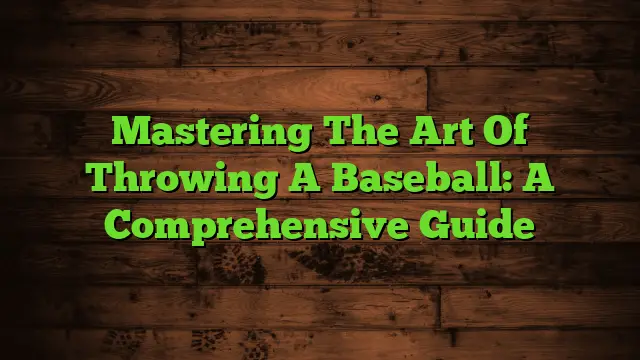Learning how to throw a baseball properly is crucial whether you’re a budding Little League player, a seasoned athlete aiming to refine your technique, or simply someone interested in understanding the mechanics of this fundamental skill. This guide will walk you through every aspect, from the grip and stance to advanced techniques and common mistakes. You’ll learn the principles behind a powerful and accurate throw, covering everything from basic mechanics to more advanced strategies. How to throw a baseball properly isn’t just about throwing far; it’s about control, precision, and understanding the physics involved. Let’s get started!
Your grip is the cornerstone of your throw. There are several common grips, but a firm yet comfortable grip is paramount. Avoid squeezing too hard, as this can
lead to fatigue and inaccuracy. Experiment to find the grip that feels most natural and provides optimal control. Common grips include the four-seam fastball, two-seam fastball, and circle changeup grips, each impacting the ball’s trajectory and speed.
Stance and Posture: Setting Yourself Up for Success
A balanced and athletic stance is crucial for generating power and accuracy. Your feet should be shoulder-width apart, knees slightly bent, and weight balanced evenly. Maintaining a relaxed yet focused posture prevents unnecessary tension, allowing for a smoother throwing motion. Imagine a coiled spring, ready to unleash its power.
The Wind-Up: Building Momentum
The windup is a preparatory phase, gathering momentum for the throw. It involves bringing the ball back behind your body, coiling your muscles, and creating kinetic energy. Different throwing styles use varying windups, but the goal remains consistent: to harness potential energy for release.
The Mechanics of the Throw: A Step-by-Step Guide
The Throwing Motion: From Wind-Up to Release
The throwing motion involves a coordinated sequence of movements: a backswing, a forward step with the throwing arm, a full extension of the arm, and finally, the release of the ball. The entire movement should be fluid and continuous, resembling a whip-like action. Proper sequencing is key to maximize velocity and accuracy.
The Release Point: The Crucial Moment of Truth
The release point determines the trajectory and velocity of the ball. It’s often described as the point where the ball leaves your hand. A high release point allows for more downward movement and can be advantageous in certain situations, whereas a lower release point is crucial for ground balls.
Follow-Through: Completing the Action
The follow-through is often overlooked, but it’s essential for completing the throwing motion and preventing injury. It involves continuing the arm motion after the ball is released. The follow-through helps stabilize the shoulder and ensures a clean, smooth release.
Types of Baseball Throws: Adapting Your Technique
Fastball: The Foundation of Any Pitching Repertoire
The fastball is the most common and fundamental pitch. Its speed is primarily determined by arm speed and throwing mechanics. Proper grip and a powerful follow-through are critical for generating velocity and accuracy.
Curveball: Mastering the Art of Deception
The curveball is a deceptive pitch that breaks downward. It requires a specific grip and wrist action to impart spin, causing the ball to curve. Mastering the curveball takes practice and precision.
Slider: A Sharper Break than the Curveball
The slider shares similarities with the curveball but offers a sharper break with less downward movement. The grip and wrist action are critical for controlling the slider’s movement.
Advanced Techniques for Improved Throwing
Improving Accuracy: Targeting and Precision
Accuracy comes from repetition and focus. Practice throwing to specific targets, concentrating on your release point, and adjusting your grip and arm angle to fine-tune accuracy. Visualize the target to enhance accuracy.
Increasing Velocity: Power and Technique
Increasing throwing velocity involves improving strength, flexibility, and technique. Strength training, plyometrics, and focusing on proper mechanics will greatly impact throwing power. Proper mechanics play a more significant role than pure strength.
Developing Control: Mastering Your Throws
Control is the ability to consistently hit your target. This combines accuracy and power. It comes through dedicated practice, honing your technique, and refining your ability to accurately hit specific targets.
Common Mistakes and How to Avoid Them
Overthrowing: The Pitfalls of Excessive Force
Overthrowing is a common mistake, often stemming from a lack of control and attempting to throw too hard. Focus on proper technique and relaxed control will help generate the required speed without sacrificing accuracy and potentially causing injury.
Poor Mechanics: The Importance of Proper Technique
Poor mechanics can lead to inaccuracy, decreased velocity, and an increased risk of injury. Focus on the fundamentals: grip, stance, wind-up, and follow-through. Seek professional guidance if needed.
Inconsistent Release Point: The Key to Accurate Throws
An inconsistent release point leads to unpredictable throws. Practice maintaining a consistent release point and arm angle to develop consistency and accuracy.
Benefits of Proper Throwing Technique
Injury Prevention: Protecting Your Body
Proper throwing technique significantly reduces the risk of injury to the shoulder, elbow, and wrist. Using the correct biomechanics and avoiding over-exertion are key factors in injury prevention.
Increased Throwing Distance: Optimizing Your Power
Mastering proper throwing mechanics enhances throwing distance by optimizing the transfer of energy through the body, increasing velocity and accuracy.
Frequently Asked Questions
What is the ideal age to start learning how to throw a baseball?
While there’s no strict age limit, children as young as 4-5 can begin developing basic throwing skills. However, formal coaching and intense training are generally recommended from ages 8-10, when coordination and strength develop more significantly.
How often should I practice throwing a baseball to see improvement?
Regular practice is essential. Aim for at least 2-3 sessions per week, even if they’re short. Consistency is key, even short practices of 15-20 minutes are preferable to infrequent longer sessions.
What type of equipment is needed for practicing?
A baseball, a glove (ideally, a quality glove for optimal control and feel), and a suitable space are the essentials. Additional equipment such as pitching machines or weighted balls can also improve strength and technique as skill progresses.
How can I improve my throwing accuracy?
Focus on your target, maintain a consistent release point, and practice throwing to specific targets. Start with closer targets and gradually increase the distance. Drills focused on target practice are vital in developing accuracy.
How can I increase my throwing velocity?
Strength and conditioning training, plyometrics (jump training), and working on efficient throwing mechanics are all crucial for increasing velocity. Proper form allows for more efficient use of your body’s power.
Are there any stretches or exercises that can help improve my throwing?
Yes! Shoulder rotations, arm circles, and stretches targeting the chest, shoulders, and back are extremely beneficial. Include strength training exercises focusing on the shoulder and upper body musculature.
Final Thoughts
Mastering the art of how to throw a baseball properly takes dedication, practice, and a commitment to understanding the underlying mechanics. By focusing on the fundamentals—grip, stance, and throwing motion—and diligently practicing, you’ll see significant improvements in accuracy, velocity, and control. Remember that consistency and proper form are key to avoiding injuries and maximizing your potential. Don’t be afraid to seek guidance from experienced coaches or trainers to refine your technique. With persistence and a focus on proper technique, you’ll unlock your full potential as a thrower. So, grab a ball and glove, and start practicing today!





